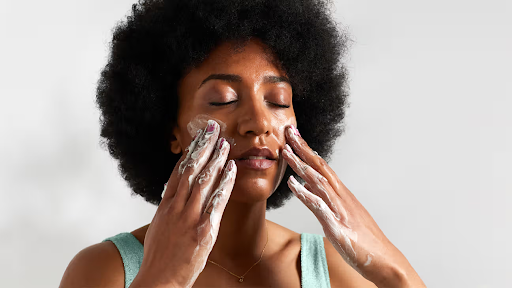People often ask, do I have sebaceous filaments or blackheads? So, in this blog, we're going to talk about the difference between the two, and how to get rid of sebaceous filaments specifically. We’ll also discuss esthetician-approved products and ingredients that effectively remove sebaceous filaments.
What is the difference between sebaceous filaments and blackheads?
Blackheads are made of the same bacteria that cause acne, but they have a blackened top. On the other hand, sebaceous filaments can be very tricky. However, a lot of people use pore strips in an attempt to get rid of them.
These sebaceous filaments can be amber or white, and when you squeeze them, they come out as a string. Sebaceous filaments also are different from blackheads because they don't contain p acnes bacteria. Sebaceous filaments are primarily composed of oil. They’re basically a sebum plug.
What causes sebaceous filaments?
Sebaceous filaments are caused by your skin's natural oil production. How often you get sebaceous filaments can also depend on your genetics, your skin products, and how thorough your skincare routine is. Moreover, factors such as genetics and likewise the size of your pores can have an impact.
How do you get sebaceous filaments out of the skin? Do pore strips work?
You don't want to pick, pull, or use pore strips on sebaceous filaments. Sebaceous filaments are simply oil plugs. And if you use strips, a sebaceous filament will likely break, and half of it will be left in the pore. Plus, pore strips aren’t great for the skin barrier because of how they tug on the stratum corneum. The best thing to use is a salicylic cleanser. Salicylic acid is oil soluble, meaning it dissolves oil. You can also use techniques like oil pulling or gritting as well.
What cleansers help sebaceous filaments?
One of Cassandra's favorite products is from Dermalogica. It's like a 2-in-1 cleanser, and it's very good for sebaceous filaments.
If you want to use an oil for cleansing, K Beauty has some really good options.
Skin 1004 and Haruharu have some excellent options that Cassandra says are wonderful for dissolving oil. If you use oil to remove sebaceous filaments, you'll want to do a massaging motion. Cassandra would recommend using your knuckles rather than your nails.
Skin1004 Madagascar Centella Light Cleansing Oil - $21
Haru Haru Wonder Black Rice Soft Cleansing Oil - $25
You can also use a skincare tool. These are expensive. So, don't just buy one for sebaceous filaments. But, if you have one, the mechanical vibration and pressure can help lift the filaments out of the pores.
The Medicube definitely helps to lift sebaceous filaments and pull them out, but the Solawave is more affordable, and it has a small vibration.
Medicube Age R

What ingredients help remove sebaceous filaments?
Salicylic acid
Once you've got the sebaceous filaments out, it's important to apply something that prevents them from returning, and salicylic acid is one of the best ingredients for doing this.
Zinc PCA and niacinamide
You can also use zinc PCA and niacinamide. You can buy a separate serum, or you can get one that combines all three. Zinc PCA and niacinamide are fantastic because they can help limit sebum production. Sebum is what clogs our skin with sebaceous filaments. If we can get our pores to make less of it, then there's a chance the pores will be less full. In turn, this allows exfoliating products to be more effective.
The Ordinary Niacinamide & Zinc - $19.99

The Bliss Clear Genius toner contains all three ingredients (salicylic acid, Zinc PCA, niacinamide) and Cassandra loves this.
Bliss Clear Genius Toner & Serum - $18
Sulfur
Sulfur is also great because it works on acne and can help with sebaceous filaments. Sulfur can help to exfoliate, and it works great as a mask.
Murad and Derma E have some amazing sulfur products. There are also some Korean products.
Murad Rapid Relief Acne Sulfur Mask- $44
Acne Free Adapalene Gel - $19.12
Retinoids
Retinoids are great because even though they don't dissolve sebaceous filaments, they help the bottom layer of your skin to produce more skin cells. When the bottom layer becomes thicker, it pushes up the skin’s top layer, and it starts to flake off. This is not exfoliation though. Retinoids simply thicken the skin, and likewise, they can help to even out the skin.
Retinoids can also help to control oil in your pores. Because of this, they can lessen sebaceous filaments by enhancing cellular turnover and making your pores look less apparent.
You can get retinol or retinal over the counter. Adapalene gel, another retinoid, is also good for wrinkles, pigmentation, and sebaceous filaments.
Sunscreen
Also, you won't want to forget sunscreen. Although the absence of sunscreen won't cause sebaceous filaments, protecting your skin from the sun can actually prevent your pores from getting larger over time. Sun exposure can damage our collagen and elastin, giving our pores more slack. In turn, larger pores may contain more sebaceous filaments.
But remember, our body naturally makes sebaceous filaments. So, remember not to stress and understand that the body is working normally.
Cover photo cred: The Greatest









